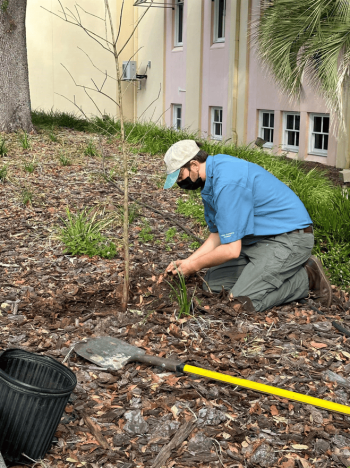
National Arbor Day is celebrated on the last Friday in April. However, here in Florida, the 1945 State Legislature designated the third Friday in January as Florida Arbor Day.
Arbor Day is a holiday dedicated to planting trees and helping them grow. People are encouraged to plant trees. Businesses and government programs may arrange communal plantings. Arbor Day in the U.S. was first proposed by Sterling Morton in Nebraska in 1872. It became a nationwide holiday in the U.S. in 1970 and is currently observed in many countries around the world.

The Headquarters Library hosted representatives from the City of Gainesville Urban Forestry Division and Keep Alachua County Beautiful for a Proper Tree Planting program (photo, right) on Sunday, Dec. 4, 2022. Attendees were able to take home free trees following the presentation and demonstration on tree planting techniques.
Keep Alachua County Beautiful will be hosting a program on Invasive Plants at the Headquarters Library on Sunday, Feb. 19 at 1 p.m. in Meeting Room B.
Trees are valuable in many ways. Here are a few reasons why:
- Trees are natural filters of air and groundwater. They remove carbon dioxide and pollutants from the environment; roadside trees reduce nearby indoor air pollution by more than 50%.
- Trees can help reduce cooling and heating bills. Properly placed trees help conserve energy by shading and cooling buildings in the summer and blocking cold winter winds. Shaded surfaces may be 20–45°F cooler than the peak temperatures of unshaded materials.
- In addition to their practical value, trees have aesthetic value. They add various colors, shapes, textures, and patterns to the landscape. Properly placed trees have a welcoming effect, provide privacy and act as ceilings for outdoor areas.
- Trees increase our property values. In Fulton County (Atlanta), Georgia, mature trees positively influenced home sale prices. Homes sold for nearly $105,000 more in neighborhoods with mature trees.
- Trees provide habitats for wildlife — birds, mammals and reptiles.
- Hairy leaf surfaces of trees trap and filter out ash, dust and pollen particles carried in the air.
- Trees contribute to our health. A study of 10 cities found community forests save an average of one life each year. In New York City, trees save an average of eight lives every year.
Learn more about trees and why they are so important from these books in our library's collection.
A Field Guide to Eastern Trees

by
Find what you're looking for with Peterson Field Guides—their field-tested visual identification system is designed to help you differentiate thousands of unique species accurately every time. This field guide features detailed descriptions of 455 species of trees native to eastern North America, including the Midwest and the South. The 48 color plates, 11 black-and-white plates, and 26 text drawings show distinctive details needed for identification. Color photographs and 266 color range maps accompany the species descriptions.
The Glory of the Tree

by
Author Noel Kingsbury presents general interest readers with an examination of ninety-one species of trees throughout the world, providing botanical descriptions, anecdotal histories, potential ages, ranges, sizes, and characteristics for each species profiled. The author has organized the main body of his text in six chapters devoted to trees in antiquity, the ecology of tree, sacred trees, the uses of trees, trees as a source of food, and trees as ornament. Noel Kingsbury is a journalist author, landscape designer and ecologist living in Wales.
Seeing Trees

by
Have you ever looked at a tree? That may sound like a silly question, but there is so much more to notice about a tree than first meets the eye. Seeing Trees celebrates seldom seen but easily observable tree traits and invites you to watch trees with the same care and sensitivity that birdwatchers watch birds. Many people, for example, are surprised to learn that oaks and maples have flowers, much less flowers that are astonishingly beautiful when viewed up close.
Focusing on widely grown trees, this captivating book describes the rewards of careful and regular tree viewing, outlines strategies for improving your observations, and describes some of the most visually interesting tree structures, including leaves, flowers, buds, leaf scars, twigs, and bark.
The Treeline

by
In the tradition of Elizabeth Kolbert and Barry Lopez, a powerful, poetic and deeply absorbing account of the "lung" at the top of the world. For the last fifty years, the trees of the boreal forest have been moving north. Ben Rawlence's The Treeline takes us along this critical frontier of our warming planet from Norway to Siberia, Alaska to Greenland, to meet the scientists, residents and trees confronting huge geological changes. Only the hardest species survive at these latitudes including the ice-loving Dahurian larch of Siberia, the antiseptic Spruce that purifies our atmosphere, the Downy birch conquering Scandinavia, the healing Balsam poplar that Native Americans use as a cure-all and the noble Scots Pine that lives longer when surrounded by its family. It is a journey of wonder and awe at the incredible creativity and resilience of these species and the mysterious workings of the forest upon which we rely for the air we breathe. Blending reportage with the latest science, The Treeline is a story of what might soon be the last forest left and what that means for the future of all life on earth.